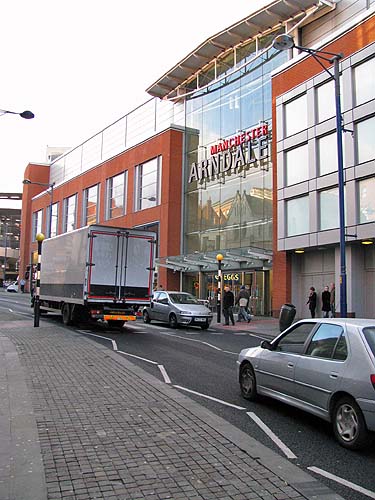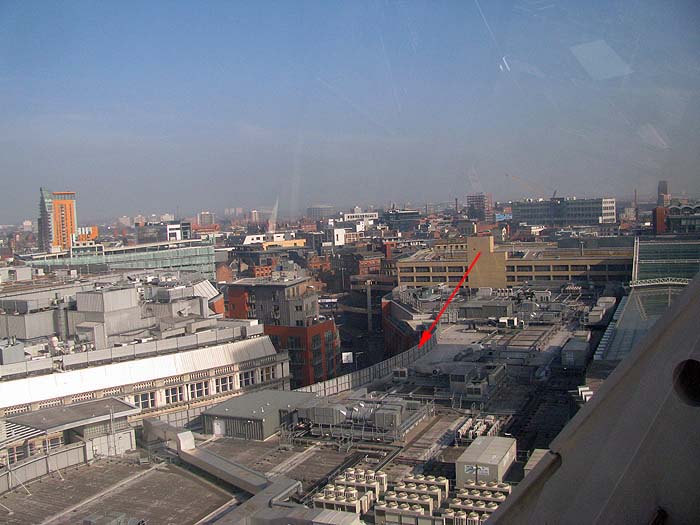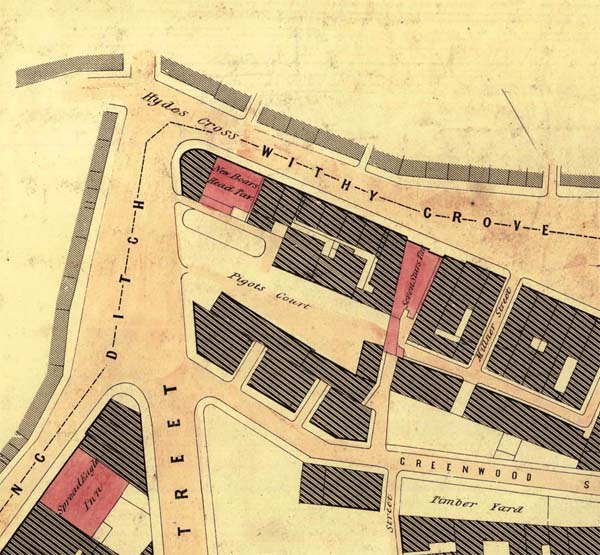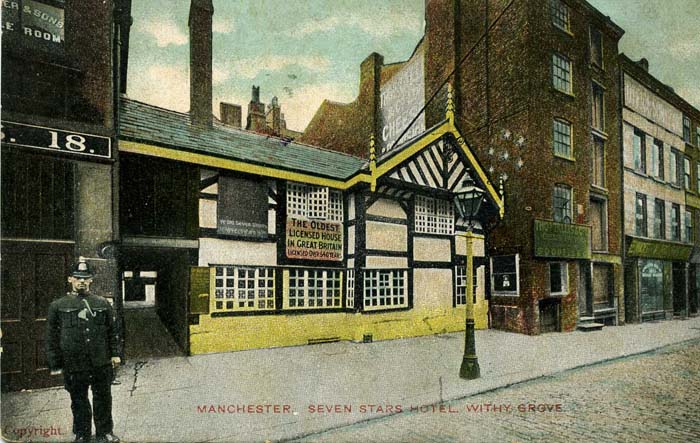|
Seven
Stars - Withy Grove
If you walk up Withy
Grove today between the Printworks and Next you will
see up ahead of you on the right an entrance to the
Arndale Centre.
 This is quite a
different sight from the one you would have seen
even a few decades ago but if you go back far enough
there would have been an old Inn here called the
Seven Stars. In the areal view below I have
marked with a red arrow the approximate location of
the Inn.
 You can see the Seven Stars on the Adshead Map excerpt below, shown with the permission of Chetham's Library.  Below is an image of the Inn complete with a passing policeman.  There are references to
the Seven Stars in "Picturesque England" by L.
Valentine and published by Frederick Warne and Co.
"Lelande
tells us that in his day (reign of Henry VIII.)
"Manchestre was the fairest, best built, quietest,
and most populous town in Lancashire." Certainly
we know that it was a picturesque town in the
reign of Elizabeth, having in it many fine old
halls, most of them of wood and plaster, fronted
in black and white, "magpie," as it was called.
The style of the inferior houses is shown in an
old tavern, called the Seven Stars, in Withy
Grove. This is believed to be the oldest licensed
public-house in Great Britain, and it has many
historical reminiscences connected with it.
The front portion of the house in Withy Grove retains much of its original character. The tap-room, kitchen, bar parlour, and vestry are in excellent preservation. The vestry was the meeting place of the gentlemen who constituted the Watch and Ward of the town. At the top of the old staircase, on entering the hotel, can be seen an old clock, which has stood there for 200 years. We read in Notes and Queries that "There is an old inn, or tavern, at the foot of Shude Hill, in Manchester, called the Seven Stars, which it is said has been a licensed house since A.D.1350; the proof of which lies in Lancaster Castle, where are deposited the records of the various licenses. I presume licenses were granted at this early period." In the Manchester City News, April 25th, 1885, it is stated that in the course of structural alterations which were being carried on at the Seven Stars Hotel, Withy Grove, Manchester, some discoveries of silver plate were made, which pointed to the conclusion that, during the Cromwellian era, that house was occupied by Charles I.'s troops, and that a then celebrated regiment of dragoons had occasion to secrete their mess plate there, in some case of emergency. The house has been licensed 511 years." *******************
"In Harrison
Ainsworth's "Guy Fawkes," a visit (authentic) of Guy
Fawkes and his companions to the Seven Stars is
described as follows:"After much debate, it was decided that their safest plan would be to proceed to Manchester, where Humphrey Chetham undertook to procure them safe lodgings at the Seven Stars, - an excellent hostel, kept by a worthy widow, who, he affirmed, would do anything to serve him. Accordingly, they set out at nightfall, - Viviana taking her place before Guy Fawkes, and relinquishing Zayda to the young merchant and the priest. Shaping their course through Worsley, by Monton Green and Pendleton, they arrived in about an hour within sight of the town, which then, - not a tithe of its present size, and unpolluted by the smoky atmosphere in which it is now constantly enveloped, - was not without some pretensions to a picturesque appearance. Crossing Salford Bridge, they mounted Smithy Bank, as it was then termed, and proceeding along Cateaton Street and Hanging Ditch, struck into Whithing (now Withy) Grove, at the right of which, just where a few houses were beginning to straggle up Shude Hill, stood, and still stands, the comfortable hostel of the Seven Stars. Here they stopped, and were warmly welcomed by its buxom mistress, Dame Sutcliffe." *******************
The book also makes
reference to the fact that:
"There is a tradition that the workmen who
built this collegiate church had a penny a day
and their meals at the old Seven Stars Hotel."
|